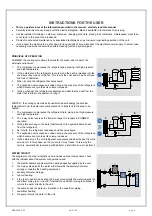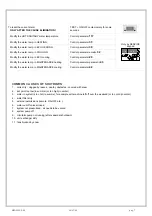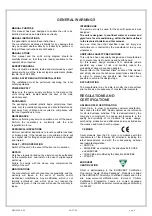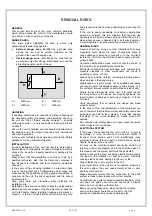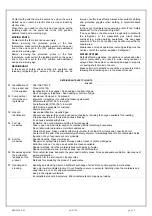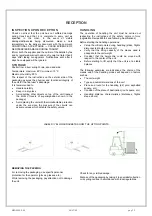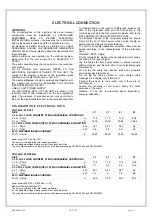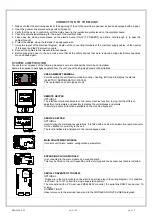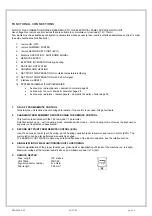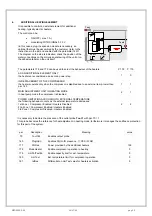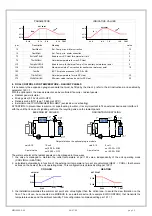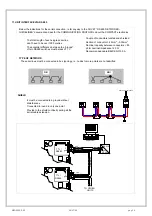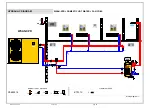
M0G940E8-00 04/07/08
pag
13
POSITIONING
GENERAL
For installing air-conditioning systems, it is necessary to
consider the following:
•
the technical spaces necessary for the machine and
system
•
the place where the machine will be installed
•
the transport of thermal carrier fluids and relevant
connections to the unit:
o
water
o
air
o
refrigerant (unit in more sections)
•
electrical connections
If these aspects are not evaluated carefully, they can affect
the performances and the working life of the unit.
FUNCTIONAL CLEARANCES
When placing the unit, please respect the functional
clearances indicated in DIMENSIONS section.
The functional spaces need to be observed because of the
following:
•
to guarantee the good operation of the unit
•
to allow the performance of all maintenance operations
•
to protect the authorized operators and exposed
people
If more units are placed close to one another, the functional
spaces must be doubled.
POSITIONING
1. The units are designed for
OUTDOOR
installations,
performed in fixed positions and in areas accessible
only to qualified and authorized personnel
2.
SAFETY VALVE
(only if present on the unit) : the
installer is responsible for evaluating the opportunity
of installing drain tubes, in conformity with the local
regulations in force ( EN 378 )
3.
Install the unit
raised
from the ground
4.
avoid installations in places subject to
flooding
5.
Consider the maximum level which can be reached by
snow
6. Verify that the fixing/supporting points are level and
suitable to support the
weight of the unit
(see the
weight and the weights distribution)
7.
It is recommended to put the unit on specific
antivibration devices
Each support point of the unit sustains a different
weight. Therefore, each anti-vibration device is sized
for a specific support point, and can only be placed
there. The anti-vibration devices must therefore be
placed in accordance with the instructions provided
with them and with the dimensional drawings in which
the support points are indicated by W1 , W2 , W3 etc .
On each anti-vibration device (if provided by CLIVET),
its identifying code is stamped, for example C6100100
Flexible joints
are necessary on all the hydraulic/
aeraulic connections (the joints are not supplied by
Clivet)
8.
Anchor
the unit to the ground; foresee windbreak
barriers in case of places where there are strong
prevalent winds .
9. During winter operation, a considerable amount of
condensation
water is produced, which must be
removed from the unit.
Make sure that removal of condensation water does
not create any problems for persons or property, such
as dripping from balconies, onto walkways, etc.
For long periods of heat pump operation with external
temperature below 0°C, the condensation might
freeze,
causing a build-up of ice. The installation of
anti-freeze heating elements should be considered.
For the units that are equipped with a condensation
drain, this is shown on the dimensional drawing.
10. The choice of the location of the unit is of fundamental
importance for correct operation; to avoid:
−
obstacles
that block the flow of air
−
difficulty in air
circulation
−
leaves
or other objects that may block the
exchanger coils
−
winds
that contrast or excessively assist the air
flow
−
phenomena of
stratification
or air
re-circulation
−
nearby
sources
of heat (chemney, extractor ecc)
−
positioning under the round level or near very high
walls
The previous situations cause working anomalies or
stop the machine and cause:
−
during SUMMER operation, increase of the
condensation pressure with the decay of
performances and possible stops due to high
pressure.
−
during WINTER operation, decrease of the
evaporation pressure with increase to the amount
of defrosting and consequent decay of the
performances and possible stops due to high
pressure
Summary of Contents for WSAN-XPR 21
Page 2: ......
Page 25: ...M0G940E8 00 04 07 08 pag 25...
Page 48: ...M0G940E8 00 04 07 08 pag 48...
Page 49: ...M0G940E8 00 04 07 08 pag 49 TECHNICAL DATA...
Page 59: ......





